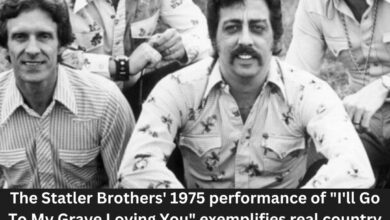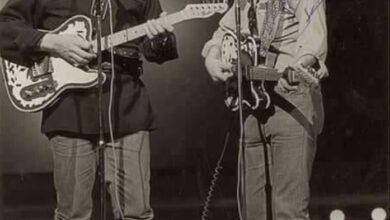Patsy Cline’s Charm Shines in “Crazy”
“Crazy” stands as a monumental piece in the history of country music, notable for its lyrical depth and emotional resonance. Written by Willie Nelson, it encapsulates feelings of vulnerability and heartbreak that often accompany love. Although Nelson penned the song, it is Patsy Cline’s stunning interpretation that has cemented its legacy. When Cline recorded “Crazy” in 1961, it not only marked a defining moment in her career but also served as a pivotal moment for the genre itself, elevating both artists and country music as a whole.
The lyrics of “Crazy” eloquently express the heartache of loving someone who has moved on. The narrator is trapped in a whirlwind of memories and emotions, unable to let go, which is a sentiment that resonates deeply with many listeners. This theme of unrequited love is a common thread in country music, often sung with a sincerity that touches the hearts of dedicated fans. Cline’s delivery, marked by her rich vocal timbre and emotional authenticity, injects life into the words, making her performance feel intensely personal and relatable. The authenticity of her interpretation allows audiences to connect on a profound level, as they see reflections of their own experiences and struggles within the song.
Cline’s commercial success following the release of “Crazy” was significant. The song reached number two on the Billboard Hot Country Songs chart and solidified her position as a leading figure in the music industry during the early 1960s. Her ability to convey emotion through song made her a beloved artist, and “Crazy” remains one of her most celebrated tracks to this day. The blend of country elements with orchestral arrangements added a lushness that further highlighted the poignant message of the lyrics, creating an atmospheric backdrop that allowed the sentiments of the song to shine through prominently.
The production of “Crazy” is noteworthy in its own right. The orchestral backdrop, featuring lush strings and a delicate piano line, creates a dreamy atmosphere that enhances the overall emotional effect of the song. This combination of traditional country instrumentation with softer, melodic lines showcases the genre’s versatility and Cline’s unique ability to blend musical styles. The rich arrangement not only complements Cline’s powerful vocals but also illustrates the emotional weight of the narrator’s despair, allowing listeners to fully immerse themselves in the heartache being expressed.
Willie Nelson’s later rendition of “Crazy,” which he recorded for his own album, reflected his unique style, melding country with elements of jazz and blues. His version, characterized by his signature laid-back vocal style and intricate guitar work, demonstrates the song’s adaptability across artists and genres. This crossing over into other musical territories showcases how great songwriting can resonate beyond its original context, appealing to a diverse audience. The song’s ability to be reinterpreted highlights the timeless and universal nature of its themes, proving that heartache and longing are experiences shared by many.
In the aftermath of Cline’s tragic passing in a plane crash in 1963, her legacy continued to grow, and “Crazy” became a song synonymous with her memory. Many believe that had she lived longer, she would have had an even more profound impact on the music world. The enduring nature of “Crazy” serves as a testament to her artistry and the emotional depth of the ballad itself. In some respects, her untimely death has amplified the song’s significance, transforming it into an emblem of her contributions to music and deepening its emotional resonance.
In the decades since its release, “Crazy” has been covered by a wide range of artists across various genres, each bringing their own interpretation to the classic. Artists such as Linda Ronstadt infused their versions with a pop sensibility, while contemporary renditions by singers like Diana Krall and Chris Isaak maintain the original’s emotional depth but reinterpret it through modern lenses. These diverse covers not only highlight the song’s versatility but also its capacity to evoke strong emotions across different contexts and styles, allowing “Crazy” to bridge generational gaps.
“Crazy” has also found its way into popular culture, including its use in films and television shows, where its themes of heartache and longing resonate with dramatic narratives. The song’s timeless appeal has seen it featured in multiple movies, often accompanying scenes underscoring the pain of love lost. Such appearances serve to further cement its status as a cultural artifact that transcends music and enters the realm of storytelling, reinforcing its connection to the shared human experience.
Patsy Cline herself, born Virginia Patterson Hensley in 1932, had a profound impact on country music. Cline broke barriers as a female artist in an industry that was predominantly male, and she was one of the first women to gain significant recognition in the genre. Her influence continues to be felt today, inspiring a new generation of female artists who view her as a pioneer for women in music. Her emotional honesty and distinctive sound have made her an enduring figure in the history of American music, and her story is a reminder of the legacy that can be left through artistic expression.
Bringing the narrative full circle, “Crazy” stands not merely as a song, but as a defining moment in the larger narrative of country music, illustrating the complexities of love and the broader human experience. From its poignant lyrics to its rich musical composition, the piece captures a depth of emotion that continues to resonate with listeners of all ages. Its lasting impact serves as a testament to the power of heartfelt songwriting and the profound ability of artists like Patsy Cline and Willie Nelson to connect with audiences through their artistry. Each performance of “Crazy” keeps the song alive, inviting new listeners to experience its beauty while honoring the legendary artists who brought it to life and shaped the landscape of music.





